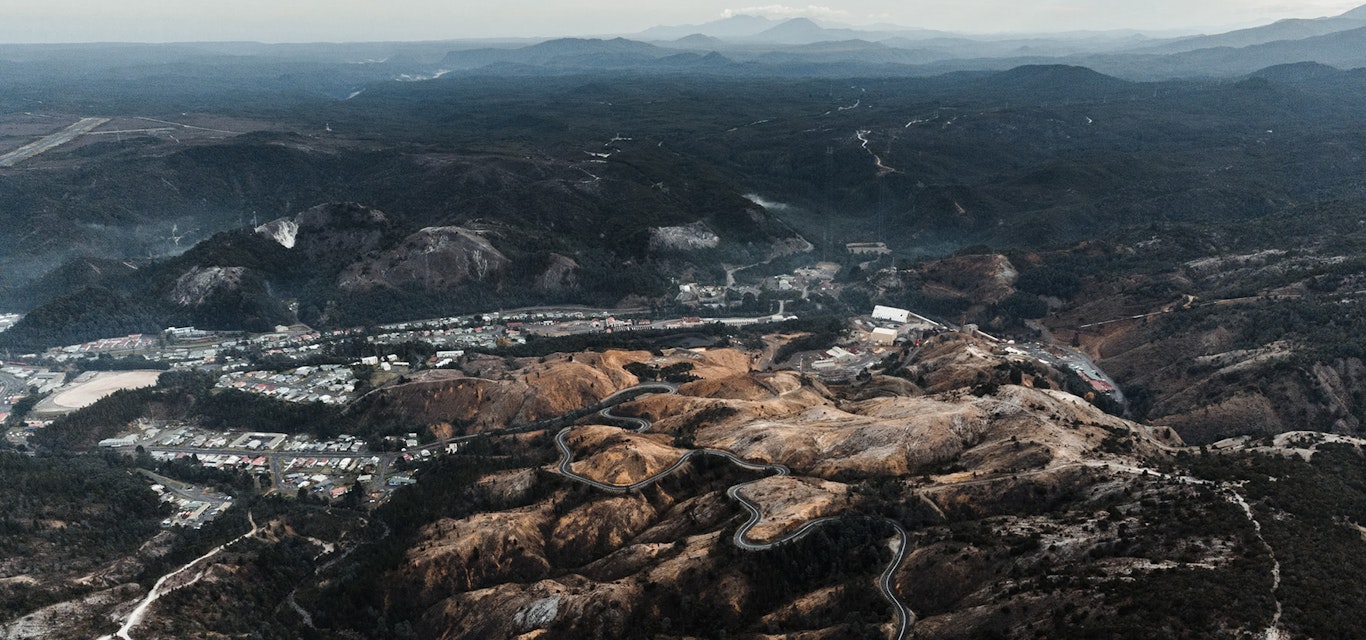Queen of the west
With a mountain bike network poised to transform the western town of Queenstown once again, we meet a creative and tight-knit community used to weathering changes.
Queenstown is no stranger to change. Born of a boom-and-bust industry, disaster and sudden loss have repeatedly rocked Tasmania’s largest west coast town. The population has exploded and drained. Before the Mount Lyell mine closed in 2014, Queenstown was already adapting to the inevitable through art, festivals, building revival, eco-tours and outdoor adventure. Yet as mountain biking takes off, or takes over, ‘Queenie’ will work to maintain its identity.
Hobart to Queenstown via the Lyell Highway is a 260-kilometre road trip that I relish. By Lake Burbury I’ve seen frosty button-grass plains, dense cool temperate rainforest and am now travelling beneath pink-tinged conglomerate peaks of the West Coast Range.
Sun drenches everything. I pay my respects to the Lowreenne and Mimegin who sustained the health and wellbeing of their traditional lands and each other, here in south-west lutruwita (Tasmania), for thousands of generations. That was before clear-felling, pyritic smelting and sulfurous rain.
On a sweeping bend near Gormanston looms the former Royal Hotel at Linda. This off-form concrete establishment opened in 1911 and last drinks were poured in 1952. It has since been stripped of everything but its potential. “All this for less than a car park in Sydney…” was what caught chef Zara Trihey’s eye.
The adjacent relocated Hydro building is now Linda Cafe. Zara, along with business partner Noona Auderset, poached chef Cassundra Hope from Byron Bay. Inside, where decor is vintage and the wood fire is crackling, a cheery Gormanston resident brunches in overalls.
I order coffee and fish stew from a chalkboard menu listing favoured ethical Tassie producers. They have loose-leaf tea, milkshakes, outdoor couches and a water bowl for visiting dogs. “We just want to create something we’d want to come to,” says Zara. After winter, the cafe reopens permanently in mid-September. Plans are also underway for the heritage-listed ruin. Hi-vis vested Aaron Stewart collects me from Linda Cafe in his West Coast Council vehicle and, minutes later, we’re hiking a future black diamond trail that winds up a ravaged hillside of reed grass and snowberries.
Aaron is project coordinator for Queenstown’s free-to-use mountain biking trail network, which will open in stages later this year.
Trail development company Dirt Art is sculpting but not overly compacting the gravelly surfaces. “That’s going to be a bit of a surprise to some people,” says Aaron. “We’re not hiding the fact they’re all pretty gnarly.” There’s nothing else remotely like this in Tasmania; aesthetically, I’m reminded of the North American high desert. Despite being an experienced rider, Aaron admits he’s still learning to gauge speed and even avoid near-vertigo when negotiating the more elevated trails through treeless landscapes.
Eleven beginner to double black diamond trails will make up four routes. Shuttles will transport riders to mountain tops with views to Frenchmans Cap. Below Horsetail Falls and on the slopes of Little Owen are rare under-canopy riding opportunities through remnant rainforest. Mount Owen will be ever-present. “A lot of the trails are a real journey,” says Aaron.
From Gormanston it’s a short, yet epic, drive to the Gold Rush Inn, where I’m staying. After Conglomerate Creek and Queenstown’s famed gravel oval, it’s an obtuse left at the original Evans store. At Orr Street, where the 120-year-old Empire Hotel stands across the road from the 125-year-old West Coast Wilderness Railway, I dogleg to the Paragon Theatre.
“We bought it to preserve it and bring it back to life again,” says Anthony Coulson in the dreamy interior of this restored 1930s former grand talkie theatre. I’ve been here before for films, live music, Friday evening drinks in summer, and joyful festival after-parties.
Anthony and partner Joy Chappell fully support mountain biking but are increasingly horrified by proposed tourism developments encroaching on the nearby Tasmanian Wilderness World Heritage Area. They suggest all Queenstown visitors engage, in some way, with conservation-focused companies such as King River Rafting, any of the Franklin River operators, and their own RoamWild.
“We’re hoping what we do can become the mechanism for conservation,” says Anthony, a former miner. “Come and help us help
the cause.”
I pass many murals walking to the nearby home-based studio and gallery of artists Helena Demczuk and Raymond Arnold, of Landscape Art Research Queenstown (LARQ). They have recently formed a collective, along with other artists like Shane Miller, to create Press West. The disused Queenstown Central Primary School will soon be a printmaking space, kitted out with new and antique presses for various techniques.
“That equipment draws people in, to work together,” says Raymond. He speaks of visual literacy, community spirit and a medium for activism. Press West aims to attract Tasmanian printmakers, as well as newcomers, and will hold workshops. “I’m always interested in people making connections on the west coast and finding the positives in it.”
Press West will launch in mid-October during the Unconformity, a visual and performing arts festival. The festival invites artists to interrogate Queenstown’s past through site-specific works and, this year, offers two residencies for lutruwita-based First Nations artists.
Graphic designer Lea Walpole is in her Orr Street studio and gallery Soggy Brolly, which features the work of local artists, such as David Fitzpatrick’s industrial material sculptures. Lea says she’s ordered an electric mountain bike but is conscious of the social impacts this next exciting chapter could have on her home town. “I don’t want us to get lost. I don’t want the authenticity of us to be erased.”
